What WERE Their Lines?
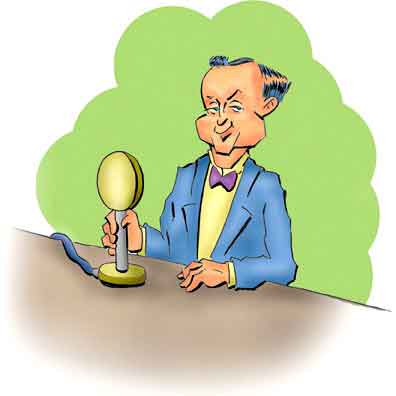
John Charles Daly
It was his line.
The Intelligensia will nod their head in approval at a tribute to the noted journalist and winner of the Peabody Award, John Charles Daly. John, as everyone has read on the Fount of All Knowledge - and it even appears to be true - was the first journalist to announce the attack on Pearl Harbor. He did so at 2:31 p. m. Eastern Standard Time, December 7, 1941. That was a little more than an hour and a half after the attack began - incredibly fast reporting for the time.
Tribute, schmibute. We're honoring the host of the famous game show What's My Line and those who appeared with him. Although television had been around since the 1920's and commercial stations started up in the late 1930's, this new medium had little effect on world culture until ordinary people started buying television sets. That didn't happen until the 1950's, and it was on February 2, 1950, that What's My Line debuted and ran for 17 seasons.
Immediately afterwards - in 1968 - the show was revived in syndication. The new host was Wally Bruner - like John a journalist - and four years later, the emcee duties were turned over to Larry Blyden, an actor who is best known for playing the two-bit hoodlum Rocky Valentine in the Twilight Zone episode "A Nice Place to Visit". The production shut down for good in 1975. Ironically it's these later shows - with the sets decked out in 1960's/1970's pastel/flower colors, visits from hippie-era celebrities, and the men sporting leisure suits and the lady contestants in the then ubiquitous miniskirts - that come off as the most dated.
But for true game show aficionados, the real What's My Line remains the episodes helmed by John Daly. Many of the shows have been released for home viewers, and you can sit in comfort and pass a laid back and entertaining half hour without having your eardrums shattered (why, we wonder, do today's television hosts and panelists always have to SHOUT).
As with so many gameshows of the era, What's My Line was the brainchild of television's dynamic duo, Mark Goodson and Bill Todman. Each show began with long-time announcer Johnny Olsen introducing the first panelist. He or she would then appear on camera - either at their desk or by walking on-stage - and then announce the next panelist. The fourth and last panelist would then introduce the host, John Charles Daly.
After a few bantering comments with the others, John would explain the show's premise and procedure. He would then ask the first guest to enter and sign in.
The contestants would walk in and write their name on a blackboard (this was the era well before digital displays). John would walk over, repeat their name, and sometimes ask where they were from. Then after meeting the panel, the guest would sit next to John and their "line" would be displayed on screen.
The questioning would begin. All queries had to be answerable by a simple "yes" or "no" although sometimes John would qualify the answer with some supplementary information. After each "no" answer, John would flip over a card from a series labeled with $5 increments. If after ten "no" answers the panel was still stumped, the contestant would win the whole amount - $50.
John was noted for his long winded and verbose clarifications. This was a humorous fit with his distinguished look and speech. John was born in South Africa in 1914 and attended the exclusive Tilton School in New Hampshire. He graduated from Boston College and then went to work as a radio reporter for NBC. He later switched to CBS and gained a national reputation as a war correspondent during World War II.
After the war John continued as a moderator and broadcast journalist. But he also began appearing in what can be seen as straight entertainment. Some of the shows had an educational slant like The Voice of Firestone, but he also had acting parts in the early television series The Front Page which was based on the play by Ben Hecht and Charles MacArthur. He also showed up on TV favorites like Father Knows Best and Death Valley Days.
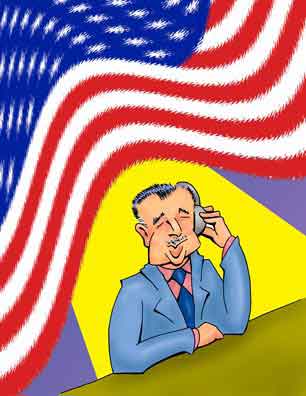
Walter Cronkite
John was his predecessor (and guest).
The What's My Line panelists started out as a rather fluid group but soon settled down to three long term staples - Random House publisher Bennett Cerf, actress Arlene Frances, and newspaper columnist and reporter Dorothy Kilgallen. Arlene had the longest run - she was on the second show and ended her tenure with the last. Comedian Hal Block was also an early panelist but his (for the time) risqué comments and behavior (such as kissing Miss America in 1952) ultimately got him booted from the panel. He was, said executive producer Gil Fates, a very strange man.
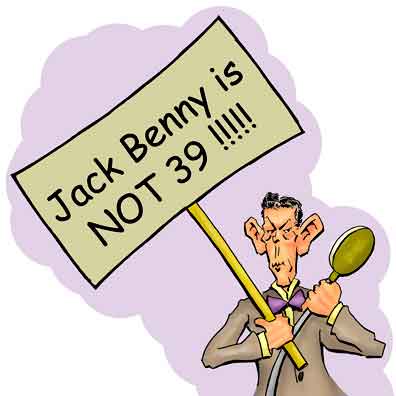
Fred Allen
Vintage Curmudgeon
The fourth panelist was usually selected from a group of semi-regulars like Arlene's husband Martin Gabel, comedian Steve Allen, ventriloqist Paul Winchell, and vintage curmudgeon Fred Allen whose career included a long-running yet rather synthetic feud with Jack Benny. There were also stand-ins and guest panelists when the regulars were out of town. These ran the gamut of Hollywood celebrities and included Betty White, Richard Boone, Joey Bishop, a pre-Tonight Show Johnny Carson and many more.
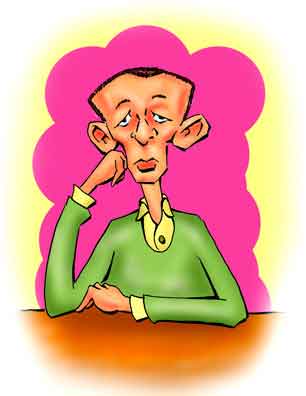
Joey Bishop
Son-of-a-Gun
But the substitutes were not restricted to the Hollywood crowd, and one popular and entertaining six-time panelist was Margaret Truman, who lived in the same apartment building as Dorothy and was the daughter of ex-President Harry Truman. Then there was the time a former sports writer turned actor was on the panel. He later went into some other line of work. Can't remember the guy's name but his initials were RR.
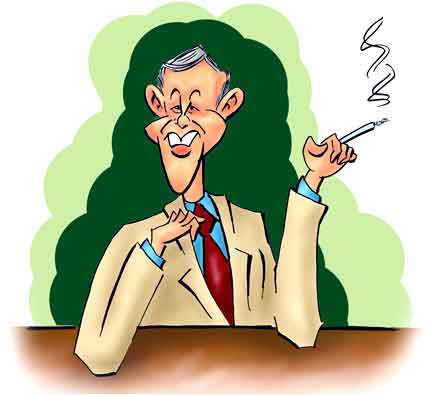
Johnny Carson
But pre-Tonight
Not all guest panelists were created equal. Groucho Marx trashed the show with his antics and Wally Cox quickly became tiresome with his string of "humorous" comments. Arlene had to step in to hurry him along. Such fiascos illustrate the Golden Rules of Humorous Game Shows: Never try to be funny. Just let the humor happen.
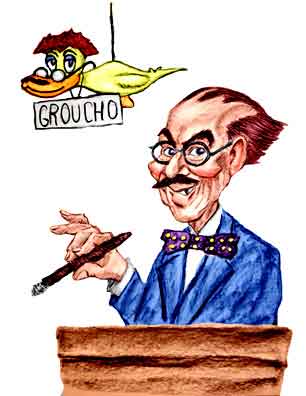
Groucho Marx
The Show Trasher
A particularly pleasant part of the early What's My Line was how few commercials they had. You might have a one minute ad at the beginning, two after about fifteen minutes, and another at the end. So the actual show - albeit with opening and closing credits - would run over 25 minutes.
Today of course a - quote - "half-hour show" - unquote - might have only 20 minutes actual time - sometimes less. And on cable you get as many if not more commercials and still have to pay your monthly fee. The irony is when cable was starting up in the 1970's some companies touted that they would remain commercial free.
Although What's My Line was not over-burdened with commercials, it is a little disconcerting to those with the modern ideas of respect to see the familiarities to which the young female contestants had to endure. Not only would John (literally) take them by the hand, but when a particularly comely young miss walked on stage, the men in the audience would break into wolf-whistles. Oh, well, at least they didn't break into "hubba-hubba" catcalls.
On the other hand, let's not be discriminatory in our censure. After all when a handsome and strapping young man came on stage, it wasn't unusual for Dorothy or Arlene to make appreciative comments. We concede the times and mores of the era were different.
Usually the first two contestants were ordinary people with jobs that ranged from the typical to the absolutely weird. You'd have doctors, lawyers, nurses, and scientists as well as harmonica tuners, makers of false eyelashes, a sculptor of wooden Indians, a hot-dog vendor at Ebbetts Field, a butler, a man who made man-hole covers, a manufacturer of jail cells, a salesman of second hand locomotives, and a broker who sold oceanliners.
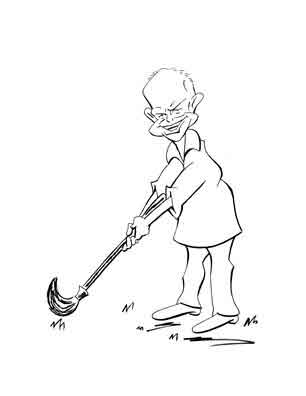
President Dwight David Eisenhower
Ike
Sometimes the guests were not famous themselves but did have occupations of no little import. Such contestants included the commanders of the US military academies at West Point, Annapolis, and Colorado Springs, college football coaches, the airplane pilot for President Dwight Eisenhower, and also Ike's caddy. You had US Navy hurricane hunters and a customs inspector who earlier in the week ushered Dorothy through the airport. Once they had three contestants on one show: a butcher, a baker, and yes, a candlestick maker.
Then there was Clarence Charles Nash. His occupation gave the panel considerable trouble, and they really never got close. He was the voice of Donald Duck.
A surprisngly modern twist for the show was the number of women with jobs that were traditionally filled by men. So you would have a nun who was a dentist, a woman marine colonel, a lady gas-station attendant, a woman airplane salesmen, a lady hog buyer, a woman dynamite maker, and a female clown with the Ringling Brothers Barnum and Bailey Circus.
Naturally the panelists wanted to appear at their sharpest. So the producers gave them a lengthy checklist of questions. The questions asked included "Is it used in the house?", "Is it decorative or utilitarian?", "Do you work for a profit-making organization?", "Do you provide a service?", and "Is there a product associated with what you do?" That the panelists worked from a prescribed crib sheet was not divuluged to the public.
Then there was the ubiquitous "Is it bigger than a breadbox?" question which was first asked by Steve Allen. This threw the panel for a loop when one particular contestant responded "No". He was a maker of breadboxes.
The most anticpated part of the show was the appearance of a - quote - "Famous Mystery Guest" - unquote - who typically appeared after the first two contestants. Of course, the panelists had to don blindfolds. John would then introduce the guest with a flourish: "Will you come in, Mystery Challenger, and SIGN IN PLEASE!"
It's amazing how many of the famous Mystery Guests are now totally forgotten. Only the most rabid of old time celebrity buffs will remember people like Adolph Green, John Hodiak, Nina Foch, Kurt Kasznar, Kathleen Winsor, Robert Q. Lewis, or Barbara Ann Scott. There were even non-human Mystery Guests whose fame has waned like Francis the Talking Mule and the marionette Howdy Doody. If there was time, there would be a third ordinary contestant to wind up the show.
We mentioned that the most anyone could win was $50. This was pretty chintzy even by the standards of the day. Some contestants walked away with nothing. Often, though, John would flip some cards over as a consolation prize. One time two college girls who washed dogs for a summer job made $25 . John flipped the rest of the cards over so they both would get that amount. Contestants who came from overseas were also often awarded the whole $50.
The Mystery Guests - and this was also not known to the general public - were paid $500 plus whatever money they won from the questions. A guest panelist was paid $750 - not bad for a 30 minute show in the 1950's. The regular panelists were under contract, and the exact amounts, though, seem to be a well-kept secret and increased as the show gained in popularity.
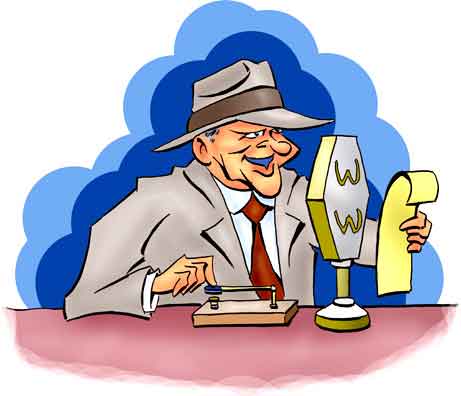
Walter Winchell
No active animosity was evident.
Although many Mystery Guests had fame that was fleeting, there were also quite a few that we remember today. There were renowned baseball stars Mickey Mantle and Willie Mays. We saw the running back Frank Gifford and quarterback Y. A. Tittle. There were less mainstream but still famous sports stars like pool players Minnesota Fats and Willie Mosconi. And there were plenty of iconic Hollywood celebrities like Jack Benny, Art Carney, John Wayne, and Debbie Reynolds (Carrie Fishers' mom).
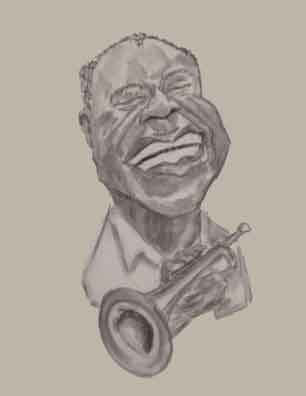
Louis Armstrong
Not all were from Hollywood or the Sports World. We even saw Eleanor Roosevelt (then a delegate to the United Nations), author of The Caine Mutiny (and former writer for Fred Allen) Herman Wouk, jazz trumpeter Louis Armstrong, and surrealistic painter Salvador Dali.
One potentially fractious Mystery Guest was the newspaper columnist and beep-beep-beep-beep radio broadcaster Walter Winchell. Before he became known to the Baby Boomers as the narrator for the hit TV show The Untouchables, Walter was one of Dorothy's major rivals in the gossip column genre. However, there was no active animosity evident.
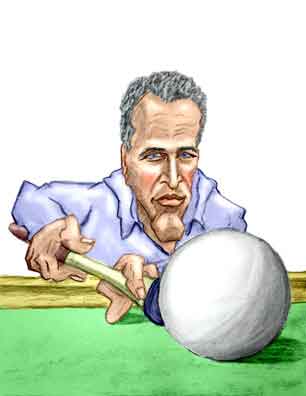
Paul Newman
He and Joanne
Sometimes the Mystery "Guest" would be married couples. You had life long partnerships like Roy Rogers and Dale Evans, Ozzie and Harriet Nelson, as well as Paul Newman and Joanne Woodward. Naturally there were also those that did not live happily ever after - such as Eddie Fisher who appeared with his (then) wife Debbie Reynolds, Les Paul and Mary Ford, and of course the smiling Desi Arnaz and Lucille Ball.
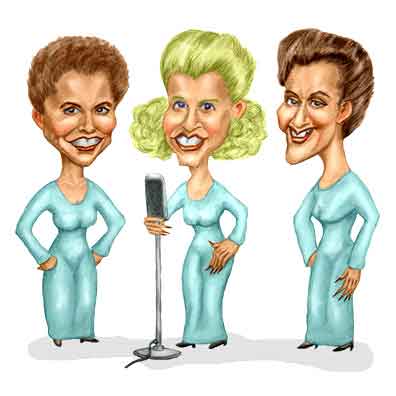
The Andrews Sisters
Maxene, and Patty, Laverne
There were also unmarried couples - and no, we don't mean that. They might be siblings such as musicians and bandleaders Tommy and Jimmy Dorsey or the young son and daughter of Dorothy. Father-daughter pairs were represented by Edgar Bergan and daughter Candice, and Bob Hope with daughter Linda. Or a duo might have a purely professional connection such as Jerry Lewis and Dean Martin, Mark Goodson and Bill Todman, and they could even be competitors such as department store owners Jack Straus (Macy's) and Bernard Gimbel (Gimbel's).
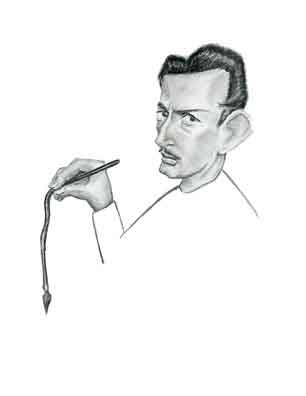
Salvador Dali
Even Him
Sometimes there were trios like the Andrews Sisters and the McGuire Sisters (of whom Phyllis would later find additional fame as the girlfriend of mobster Sam Giancana). There were even larger conglomerates like the "Von Trapp Children", the Harlem Globetrotters, the June Taylor Dancers, the Cincinnati Reds baseball team, the CBS news correspondents who covered the 1956 Chicago presidential convention (which included Walter Cronkite), and the entire crew of a US Navy submarine.
The very first Mystery Guest on the very first show was Phil Rizzuto. Phil was the shortstop for the New York Yankees, and yet some of the panelists didn't know who he was. So in the future the producers made sure they went for top-named stars. To show you how times have a-changed, in the off season Phil, an elite professional athelete, worked in a local clothing store.
Another shock will be to those who think that panel shows featuring politicians started with Have I Got News for You. On What's My Line you'll see senators, congressmen and congresswomen, governors, and even a former Lord Mayor of Dublin, Ireland, Robert Briscoe - who happened to be Jewish.
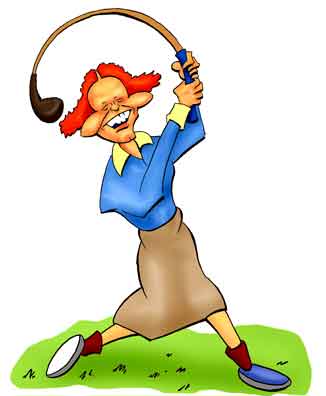
Patty Berg
They didn't recognize her.
What will particularly shock! shock! viewers is when there appeared quite famous celebrities and yet the panel did not need the blindfolds. But this was the time when photography was cumbersome and printing techniques difficult. So it was a far less visual era. Although the guests signed in as Mr. or Mrs. "X", the panel did not recognize Arnold Palmer (who had just won his first Masters Tournament), LPGA co-founder and champion Patty Berg, and underwater explorer Jacques Cousteau. However, although in the early 1950's when Sir Edmund Hillary appeared on To Tell the Truth the panel did not need to be blindfolded, by the time he was a Mystery Guest on What's My Line his face was so well known the blindfolds were needed.
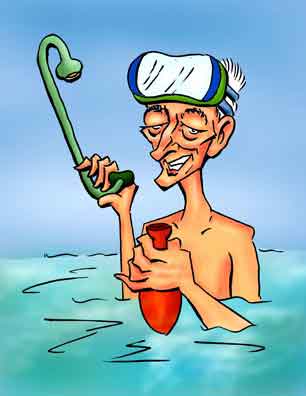
Jacques Cousteau
Or him.
Sometimes the panel would also be blindfolded for ordinary contestants when there might be an element of recognition. Certainly they had to cover their eyes when a Buckingham Palace Guard appeared in full reglia and when a Salvation Army band came on stage in uniform and with their instruments (and yes, they did play a tune). There were also some contestants who were not major celebrities but had been in the news such as Florence Chadwick, the first woman to swim the English Channel
Sometimes family members of the panelists would be contestants. Naturally everyone had to put on the blindfolds. The spouses of Bennett and Dorothy appeared as did Dorothy's father, James Kilgallen (himself a well-known journalist). When it turned out the Mystery Guest was Fred Allen's wife, Portland, it was interesting to watch Fred's reaction. When he removed the mask he was clearly surprised, but also pleased to see her. For all Fred's grumpy persona, he and Portland were happily married nearly 30 years.
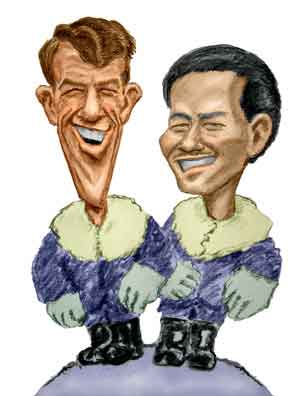
Edmund Hillary and Tenzing Norgay
Edmund was a guest; Tenzing was not.
One of the funniest episodes was when John snuck in the teenaged Peter Gabel, the son of Arlene and Martin. Peter's "line" was that he was a guide at the New York World's Fair. He stumped the panel.
When Arlene found out who it was she said, "You told me you were working at the fair late tonight, and I believed you!"
"I knew it would require the utmost deception to deceive you, Mother," Peter replied.
There were a few sad spots. Fred Allen died unexpectedly on Saturday, March 17, 1956. He had been scheduled to appear on the panel the next day. When John called Portland about doing a special show about Fred, she suggested carrying on as if Fred was still there. Steve Allen, by then a fairly regular panelist, took his place.
Then on the day following the show of November 7, 1965, Dorothy Kilgallen was found dead in her apartment. The official ruling was an overdose of alcohol and sleeping pills. There are of course the inevitable rumors that her death was contrived by organized crime because of her reporting on the mob or that it was related to John Kennedy's assassination. But it was widely accepted that Dorothy had a long time drug and alcohol problem. On one program where she introduced Bennett Cerf she stumbled over her lines so badly that many people assumed she was under the influence. However, if you watch the whole show she seemed perfectly normal afterwards.
The John Daly era of What's My Line ended on December 3, 1967. For the final show they were able to locate the first contestant from the first broadcast. She had been a hatcheck girl in her first appearance but now was an actress specializing in television commercials. The Mystery Guest - of course - was John Charles Daly.
References
What's My Line?: The Inside History of TV's Most Famous Panel Show, Gil Fates, Prentice-Hall, 1978
John Daly (1914-1991), Internet Movie Data Base.
What's My Line, John Daly (presenter), 1950 - 1967, Internet Movie Data Base
"Wonder What's Their Line", Don Royal, Oxnard Press Courier, February 29, 1965.
"Will Cable TV Be Invaded by Commercials?", Sandra Salmans, The New York Times, July 26, 1981.
"John Daly", Variety, March 3, 1991.